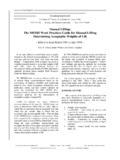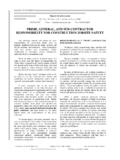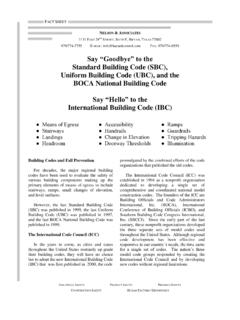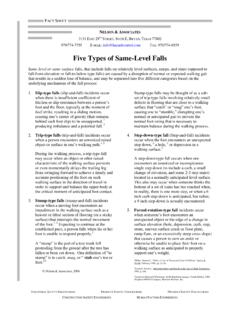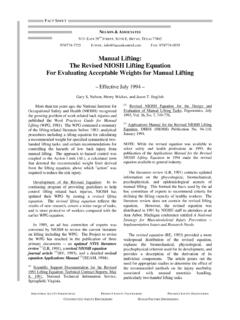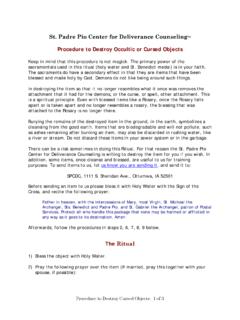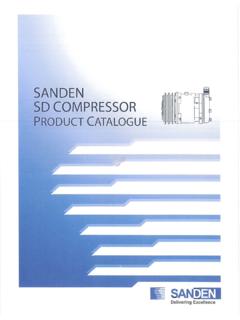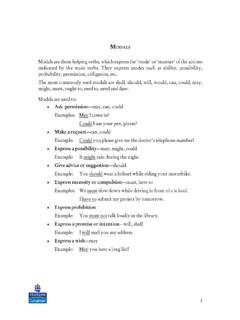Transcription of FALLING OBJECTS CALCULATIONS a - …
1 INDUSTRIAL SAFETY ENGINEERING PRODUCT SAFETY ENGINEERING PREMISES SAFETY ENGINEERING CONSTRUCTION SAFETY ENGINEERING HUMAN FACTORS ENGINEERING FACT SHEET NELSON & ASSOCIATES 3131 EAST 29TH STREET, SUITE E, BRYAN, TEXAS 77802 979/774-7755 E-MAIL: FAX: 979/774-0559 PHYSICS CALCULATIONS RELATED TO FALLING OBJECTS Gary S. Nelson and Timothy D. Snowden The physical characteristics of various falls and associated CALCULATIONS related to fall dynamics and force of impact (potential severity) illustrate the critical importance of fall prevention and the use of various fall protection control structures, devices, and activities.
2 VELOCITY UPON IMPACT (v) v = (vo2 + 2gs)1/2 or 2gs)(vv2o+= where: v = velocity upon impact (ft/s) vo = initial velocity (ft/s) g = acceleration due to gravity ( ft/s2 ) s = distance of the fall (ft) RATE OF DECELERATION (a) 2dva2= where: a = rate of deceleration (ft/s2 ) v = the velocity at the point of impact (ft/s) d = deceleration distance (ft) G-FORCE (G) (Conversion of rate of deceleration to G-force) gaG= where: G = G-force a = rate of deceleration (ft/s2 ) g = acceleration due to gravity ( ft/s2 ) FORCE OF IMPACT (F i) WGgWaFi== where: Fi = force of impact (pounds force) W = object weight (lbs) a = rate of deceleration (ft/s2 ) g = acceleration due to gravity ( ft/s2 ) G = G-force 2 INDUSTRIAL SAFETY ENGINEERING PRODUCT SAFETY ENGINEERING PREMISES SAFETY ENGINEERING CONSTRUCTION SAFETY ENGINEERING HUMAN FACTORS ENGINEERING TIME TO FALL (t) BASED ON DISTANCE OF FALL (s) g2st= where: t = time (sec) s = distance (ft) g = ft/s2 PRESSURE OF IMPACT (P i) iiiAFP= where.
3 Pi = pressure of impact (force per unit area in lbs/in2 ) Fi = force of impact (pounds force) Ai = surface area of impact (in2 ) ABILITY OF OBJECTS TO WITHSTAND FORCE OF IMPACT F = sA where: s = stress absorption characteristics of the impacted material A = the area over which the force is applied Regarding the ability of OBJECTS to withstand a force and pressure of impact without injury, one must compare the induced stress of impact (force of impact) to the tensile, compression, shear, puncture, and bending stress that the object being impacted can withstand without damage.
4 Injury to the human body can occur due to direct impact forces, or due to transferred energy to underlying structures when such impact force is transferred to other elements of the body, such as muscles, ligaments, bones, and joints. The time available for the absorption of impact forces (the absorption rate) will also affect the degree of injury. NOTE: If the object weight is greater than indicated, force and pressure of impact will increase. If the object weight is less than indicated, force and pressure of impact will decrease. If the fall distance is greater than indicated, force and pressure of impact will increase.
5 If the fall distance is less than indicated, force and pressure of impact will decrease. If the deceleration distance is greater than indicated, force and pressure of impact will decrease. If the deceleration distance is less than indicated, force and pressure of impact will increase. If the area of impact is greater than indicated, pressure of impact will decrease. If the area if impact is less than indicated, pressure of impact will increase. PHYSICS CALCULATIONS RELATED TO FALLING OBJECTS (CONT D) SEE PAGES 3-8 FOR EXAMPLE CALCULATIONS SEE PAGE 9 (Appendix A) FOR COMPARISONS TO OTHER PRESSURES SEE PAGE 10 (Appendix B) FOR INFORMATION ON (IN)2 VS.
6 SQ. IN. 3 INDUSTRIAL SAFETY ENGINEERING PRODUCT SAFETY ENGINEERING PREMISES SAFETY ENGINEERING CONSTRUCTION SAFETY ENGINEERING HUMAN FACTORS ENGINEERING EXAMPLE CALCULATIONS Example 1 SCENARIO A 6 pound brick, 6 inches by 4 inches by 2 inches, falls 11 feet, and the 6 inch (right angle) edge strikes a man in the back who is performing work in a kneeling position, assuming 1/4 inch deceleration distance. VELOCITY UPON IMPACT (v) v = (vo2 + 2gs)1/2 or 2gs)(vv2o+= where: v = velocity upon impact (ft/s) vo = initial velocity (ft/s) g = acceleration due to gravity ( ft/s2 ) s = distance of the fall (ft) )]11)( (20[v+= v = ft/s RATE OF DECELERATION (a) 2dva2= where: a = rate of deceleration (ft/s2 ) v = the velocity at the point of impact (ft/s) d = deceleration distance (ft) )*2(1/4( )a1212= a = 17,002 ft/s2 G-FORCE (G) (Conversion of rate of deceleration to G-force) gaG= where.
7 G = G-force a = rate of deceleration (ft/s2 ) g = acceleration due to gravity ( ft/s2 ) G = 17002 G = 528 FORCE OF IMPACT (Fi) WGgWaFi== where: Fi = force of impact (pounds force) W = object weight (lbs) a = rate of deceleration (ft/s2 ) g = acceleration due to gravity ( ft/s2 ) G = G-force Fi = 6 x 528 Fi = 3,168 lbs force TIME TO FALL (t) BASED ON DISTANCE OF FALL (s) g2st= where: t = time (sec) s = distance (ft) g = ft/s2 (11)t= t = seconds PRESSURE OF IMPACT (P) iiiAFP= where.
8 Pi = pressure of impact (force per unit area in lbs/in2 ) Fi = force of impact (pounds force) A i = surface area of impact (in2 ) Pi = Pi = 2,112 lbs/in2 4 INDUSTRIAL SAFETY ENGINEERING PRODUCT SAFETY ENGINEERING PREMISES SAFETY ENGINEERING CONSTRUCTION SAFETY ENGINEERING HUMAN FACTORS ENGINEERING Example 1 (cont.) VARIATIONS IN THE SCENARIO: Various striking configurations for object FALLING on back: Distance of Fall (ft)Velocity on Impact (ft/s)Deceleration Distance (in)Rate of Deceleration (ft/s^2)Weight (lbs-force)Force of Impact (lbs-force)Time (s)Area of Impact (in^2)Pressure of Impact (lbs/in^2) , ,440 2460 Strikes , ,440 1 1/2960 Strikes on 6" , ,440 ,040 Strikes on , ,168 24132 Strikes , ,168 1 1/22,112 Strikes on 6" , ,168 ,688 Strikes on corner object FALLING on head.
9 Distance of Fall (ft)Velocity on Impact (ft/s)Deceleration Distance (in)Rate of Deceleration (ft/s^2)Weight (lbs-force)Force of Impact (lbs-force)Time (s)Area of Impact (in^2)Pressure of Impact (lbs/in^2) , ,440 ,520 Strikes , ,440 ,520 Strikes on 6" , ,440 ,520 Strikes on , ,168 ,344 Strikes , ,168 ,344 Strikes on 6" , ,168 ,344 Strikes on corner5 INDUSTRIAL SAFETY ENGINEERING PRODUCT SAFETY ENGINEERING PREMISES SAFETY ENGINEERING CONSTRUCTION SAFETY ENGINEERING HUMAN FACTORS ENGINEERING EXAMPLE CALCULATIONS Example 2 SCENARIO A worker weighing 172 pounds falls 11 feet to land on his hip or shoulder on a surface that deflects 1 foot upon impact.
10 VELOCITY UPON IMPACT (v) v = (vo2 + 2gs)1/2 or 2gs)(vv2o+= where: v = velocity upon impact (ft/s) vo = initial velocity (ft/s) g = acceleration due to gravity ( ft/s2 ) s = distance of the fall (ft) )]11)( (20[v+= v = ft/s RATE OF DECELERATION (a) 2dva2= where: a = rate of deceleration (ft/s2 ) v = the velocity at the point of impact (ft/s) d = deceleration distance (ft) )*2(12( )a1212= a = 354 ft/s2 G-FORCE (G) (Conversion of rate of deceleration to G-force) gaG= where: G = G-force a = rate of deceleration (ft/s2 ) g = acceleration due to gravity ( ft/s2 ) G = 354 G = 11 FORCE OF IMPACT (Fi) WGgWaFi== where: Fi = force of impact (pounds force) W = object weight (lbs) a = rate of deceleration (ft/s2 ) g = acceleration due to gravity ( ft/s2 ) G = G-force Fi = 172 x 11 Fi = 1,892 lbs force TIME TO FALL (t) BASED ON DISTANCE OF FALL (s) g2st= where: t = time (sec) s = distance (ft) g = ft/s2 (11)t= t = seconds PRESSURE OF IMPACT (P) iiiAFP= where.
